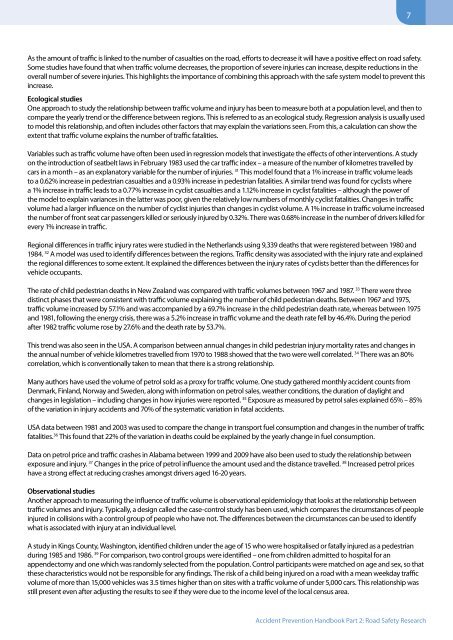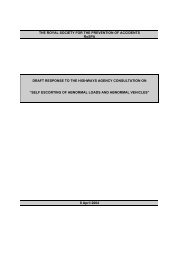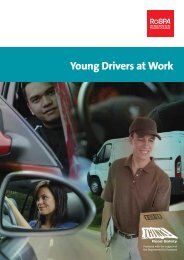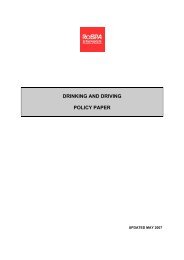Road safety policy and links to wider objectives - RoSPA
Road safety policy and links to wider objectives - RoSPA
Road safety policy and links to wider objectives - RoSPA
Create successful ePaper yourself
Turn your PDF publications into a flip-book with our unique Google optimized e-Paper software.
77<br />
As the amount of traffic is linked <strong>to</strong> the number of casualties on the road, efforts <strong>to</strong> decrease it will have a positive effect on road <strong>safety</strong>.<br />
Some studies have found that when traffic volume decreases, the proportion of severe injuries can increase, despite reductions in the<br />
overall number of severe injuries. This highlights the importance of combining this approach with the safe system model <strong>to</strong> prevent this<br />
increase.<br />
Ecological studies<br />
One approach <strong>to</strong> study the relationship between traffic volume <strong>and</strong> injury has been <strong>to</strong> measure both at a population level, <strong>and</strong> then <strong>to</strong><br />
compare the yearly trend or the difference between regions. This is referred <strong>to</strong> as an ecological study. Regression analysis is usually used<br />
<strong>to</strong> model this relationship, <strong>and</strong> often includes other fac<strong>to</strong>rs that may explain the variations seen. From this, a calculation can show the<br />
extent that traffic volume explains the number of traffic fatalities.<br />
Variables such as traffic volume have often been used in regression models that investigate the effects of other interventions. A study<br />
on the introduction of seatbelt laws in February 1983 used the car traffic index – a measure of the number of kilometres travelled by<br />
cars in a month – as an explana<strong>to</strong>ry variable for the number of injuries. 31 This model found that a 1% increase in traffic volume leads<br />
<strong>to</strong> a 0.62% increase in pedestrian casualties <strong>and</strong> a 0.93% increase in pedestrian fatalities. A similar trend was found for cyclists where<br />
a 1% increase in traffic leads <strong>to</strong> a 0.77% increase in cyclist casualties <strong>and</strong> a 1.12% increase in cyclist fatalities – although the power of<br />
the model <strong>to</strong> explain variances in the latter was poor, given the relatively low numbers of monthly cyclist fatalities. Changes in traffic<br />
volume had a larger influence on the number of cyclist injuries than changes in cyclist volume. A 1% increase in traffic volume increased<br />
the number of front seat car passengers killed or seriously injured by 0.32%. There was 0.68% increase in the number of drivers killed for<br />
every 1% increase in traffic.<br />
Regional differences in traffic injury rates were studied in the Netherl<strong>and</strong>s using 9,339 deaths that were registered between 1980 <strong>and</strong><br />
1984. 32 A model was used <strong>to</strong> identify differences between the regions. Traffic density was associated with the injury rate <strong>and</strong> explained<br />
the regional differences <strong>to</strong> some extent. It explained the differences between the injury rates of cyclists better than the differences for<br />
vehicle occupants.<br />
The rate of child pedestrian deaths in New Zeal<strong>and</strong> was compared with traffic volumes between 1967 <strong>and</strong> 1987. 33 There were three<br />
distinct phases that were consistent with traffic volume explaining the number of child pedestrian deaths. Between 1967 <strong>and</strong> 1975,<br />
traffic volume increased by 57.1% <strong>and</strong> was accompanied by a 69.7% increase in the child pedestrian death rate, whereas between 1975<br />
<strong>and</strong> 1981, following the energy crisis, there was a 5.2% increase in traffic volume <strong>and</strong> the death rate fell by 46.4%. During the period<br />
after 1982 traffic volume rose by 27.6% <strong>and</strong> the death rate by 53.7%.<br />
This trend was also seen in the USA. A comparison between annual changes in child pedestrian injury mortality rates <strong>and</strong> changes in<br />
the annual number of vehicle kilometres travelled from 1970 <strong>to</strong> 1988 showed that the two were well correlated. 34 There was an 80%<br />
correlation, which is conventionally taken <strong>to</strong> mean that there is a strong relationship.<br />
Many authors have used the volume of petrol sold as a proxy for traffic volume. One study gathered monthly accident counts from<br />
Denmark, Finl<strong>and</strong>, Norway <strong>and</strong> Sweden, along with information on petrol sales, weather conditions, the duration of daylight <strong>and</strong><br />
changes in legislation – including changes in how injuries were reported. 35 Exposure as measured by petrol sales explained 65% – 85%<br />
of the variation in injury accidents <strong>and</strong> 70% of the systematic variation in fatal accidents.<br />
USA data between 1981 <strong>and</strong> 2003 was used <strong>to</strong> compare the change in transport fuel consumption <strong>and</strong> changes in the number of traffic<br />
fatalities. 36 This found that 22% of the variation in deaths could be explained by the yearly change in fuel consumption.<br />
Data on petrol price <strong>and</strong> traffic crashes in Alabama between 1999 <strong>and</strong> 2009 have also been used <strong>to</strong> study the relationship between<br />
exposure <strong>and</strong> injury. 37 Changes in the price of petrol influence the amount used <strong>and</strong> the distance travelled. 38 Increased petrol prices<br />
have a strong effect at reducing crashes amongst drivers aged 16-20 years.<br />
Observational studies<br />
Another approach <strong>to</strong> measuring the influence of traffic volume is observational epidemiology that looks at the relationship between<br />
traffic volumes <strong>and</strong> injury. Typically, a design called the case-control study has been used, which compares the circumstances of people<br />
injured in collisions with a control group of people who have not. The differences between the circumstances can be used <strong>to</strong> identify<br />
what is associated with injury at an individual level.<br />
A study in Kings County, Washing<strong>to</strong>n, identified children under the age of 15 who were hospitalised or fatally injured as a pedestrian<br />
during 1985 <strong>and</strong> 1986. 39 For comparison, two control groups were identified – one from children admitted <strong>to</strong> hospital for an<br />
appendec<strong>to</strong>my <strong>and</strong> one which was r<strong>and</strong>omly selected from the population. Control participants were matched on age <strong>and</strong> sex, so that<br />
these characteristics would not be responsible for any findings. The risk of a child being injured on a road with a mean weekday traffic<br />
volume of more than 15,000 vehicles was 3.5 times higher than on sites with a traffic volume of under 5,000 cars. This relationship was<br />
still present even after adjusting the results <strong>to</strong> see if they were due <strong>to</strong> the income level of the local census area.<br />
Accident Prevention H<strong>and</strong>book Part 2: <strong>Road</strong> Safety Research

















